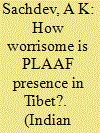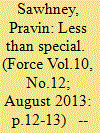|
|
|
Sort Order |
|
|
|
Items / Page
|
|
|
|
|
|
|
| Srl | Item |
| 1 |
ID:
154282


|
|
|
|
|
| Summary/Abstract |
The threat of co-ordinated action by China and Pakistan is a distinct possibility and, under such a scenario, the IAF would have to spread its assets on two fronts, that would render the PLAAF threat from Tibet even more worrisome. How worrisome would that threat be? The IAF is now posturing in the East to counter the PLAAF presence in Tibet. While the apparition of a two-front war does haunt the Indian psyche, there are counter arguments to suggest that in the event of a Chinese aggression a la 1962, Pakistan may be held back by international pressure led by the US, to desist from opening up another front.
|
|
|
|
|
|
|
|
|
|
|
|
|
|
|
|
| 2 |
ID:
126145


|
|
|
|
|
| Publication |
2013.
|
| Summary/Abstract |
Special Forces (SF) in India have an existential dilemma. On the one hand the absolute defensive approach of the government to national security makes SF unnecessary. On the other hand senior military commanders rarely understand that special operations are qualitatively different from regular warfare, not a sub-category of it. Talks, therefore, of raising SF command is putting the cart before the horse. The need is to first resolve the fundamental issues at the political and military levels.
|
|
|
|
|
|
|
|
|
|
|
|
|
|
|
|
| 3 |
ID:
103298


|
|
|
|
|
| Publication |
2011.
|
| Summary/Abstract |
On 11 September 2010, the United States commemorated the ninth anniversary of the 9/11 attacks. In those nine years, British forces have been engaged in military operations of unexpected location, intensity, scale and duration. While the performance of British troops has been repeatedly praised on these operations, there has been growing disquiet among commentators and, indeed, among the military establishment itself about the conduct of these campaigns. Specifically, the issue of British military command has come under increasing scrutiny. This article examines command frictions at the strategic and operational levels and seeks to provide a sociological explanation of these difficulties. It claims that British commanders have failed to identify a coherent strategy over the past decade while in-theatre operational command has often been characterized by an ad hoc-ery, incoherence and inconsistency. The article suggests that a 'laissez faire' command culture has been evident at strategic and operational levels. While individual mistakes may not be irrelevant, the article explores the way in which this command culture may be a product of institutional pressures within defence and, above all, a product of inter-service rivalry. However, the laissez faire system of command in the armed forces may also be a reflection of much deeper cultural presumptions and preferences within British professional society itself which has always had a strong tendency towards pragmatism, decentralization and shorttermism. The article concludes by offering some suggestions as to how military command might be reformed in light of its potentially profound cultural origins.
|
|
|
|
|
|
|
|
|
|
|
|
|
|
|
|
| 4 |
ID:
047488


|
|
|
|
|
| Publication |
New Delhi, Manas Publications, 2000.
|
| Description |
2v. (624p.)
|
| Standard Number |
8170491231
|
|
|
|
|
|
|
|
|
|
|
|
Copies: C:2/I:0,R:0,Q:0
Circulation
| Accession# | Call# | Current Location | Status | Policy | Location |
| 043472 | 355.020954/GUL 043472 | Main | On Shelf | General | |
| 043473 | 355.020954/GUL 043473 | Main | On Shelf | General | |
|
|
|
|
| 5 |
ID:
116248


|
|
|
|
|
| Publication |
2012.
|
| Summary/Abstract |
Space assets represent the most critical undefended resource of the United States. Though the government has clearly been aware of this weakness for over a generation, little appears to have been done about it. Every day these assets become more critical, and the threats against them are growing in kind. The United States must address these threats in order to prevent potential future issues in regard to military command and control, as well as the American way of life. This article not only outlines threats to space assets but proposes means by which U.S. space assets could be protected. Such protection comes not only from technology, which has been capable for years of doing the job, but from policy choice as well. In regard to policy, increasing research and development for space-based weapons, reevaluating existing treaties, and increasing interagency cooperation are all needed to better protect U.S. space assets.
|
|
|
|
|
|
|
|
|
|
|
|
|
|
|
|
|
|
|
|
|